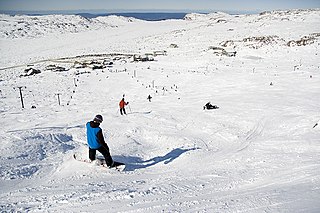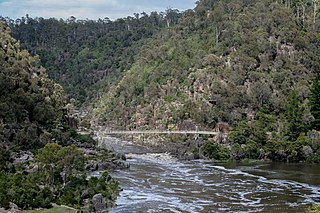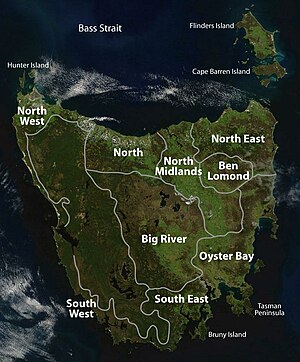
The Aboriginal Tasmanians are the Aboriginal people of the Australian island of Tasmania, located south of the mainland. For much of the 20th century, the Tasmanian Aboriginal people were widely, and erroneously, thought of as being an extinct cultural and ethnic group that had been intentionally exterminated by white settlers. Contemporary figures (2016) for the number of people of Tasmanian Aboriginal descent vary according to the criteria used to determine this identity, ranging from 6,000 to over 23,000.
The Wilson River language, also known as "Modern" Wankumara, is an Australian Aboriginal language of the Karnic family. It was spoken by several peoples along the Wilson River in Queensland. Of these, the Wanggumara (Wangkumara) and Galali may have migrated from the Bulloo River and abandoned their language when they arrived.

Ben Lomond is a mountain in the north-east of Tasmania, Australia.

The South Esk River, the longest river in Tasmania, is a major perennial river located in the northern region of Tasmania, Australia.
The languages of Australia are the major historic and current languages used in Australia and its offshore islands. Over 250 Australian Aboriginal languages are thought to have existed at the time of first European contact. English is the majority language of Australia today. Although English has no official legal status, it is the de facto official and national language. Australian English is a major variety of the language with a distinctive accent and lexicon, and differs slightly from other varieties of English in grammar and spelling.
Palawa kani is a constructed language created by the Tasmanian Aboriginal Centre as a composite Tasmanian language, based on reconstructed vocabulary from the limited accounts of the various languages once spoken by the Aboriginal people living on the island now known as Tasmania or lutruwita.

Northeastern Tasmanian is an aboriginal language family of Tasmania in the reconstruction of Claire Bowern.

Eastern Tasmanian is an aboriginal language family of Tasmania in the reconstruction of Claire Bowern.

Western Tasmanian is an aboriginal language family of Tasmania in the reconstruction of Claire Bowern.
Port Sorell is an extinct aboriginal language of Tasmania in the reconstruction of Claire Bowern. It was spoken near Port Sorell, in the center of the north coast, just east of Northern Tasmanian proper. Dixon & Crowley agree that there is unlikely to be a close connection to other varieties of Tasmanian.
Northwestern Tasmanian, or Peerapper ("Pirapa"), is an aboriginal language of Tasmania in the reconstruction of Claire Bowern. It was spoken along the west coast of the island, from Macquarie Harbour north to Circular Head and Robbins Island.
Southwestern Tasmanian, or Toogee, is a possible aboriginal language of Tasmania. It is the most poorly attested known variety of Tasmanian, and it is not clear how distinct it was. It was apparently spoken along the west coast of the island, south of Macquarie Harbour.
Northeastern Tasmanian, or Pyemmairre, is an aboriginal language of Tasmania.
North Midland Tasmanian, or Tyerrernotepanner ("Cheranotipana"), was an aboriginal language of northeastern Tasmania, along the Tamar River and inland of Ben Lomond and Great Oyster Bay.
Little Swanport Tasmanian is an aboriginal language of Tasmania in the reconstruction of Claire Bowern. It was spoken near the modern town of Little Swanport on the east coast. Dixon & Crowley had noted that it appeared to be distinct, but were not sure if it constituted a separate language from other word lists collected near Oyster Bay.
Paredarerme is an aboriginal language of Tasmania in the reconstruction of Claire Bowern. It was spoken along the central eastern coast of the island by the Oyster Bay tribe, and in the interior by the Big River tribe. Records of the Big River dialect, Lairmairrener ("Lemerina"), indicate that it was no more distinct than the vocabularies collected along the coast around Oyster Bay; indeed, Little Swanport appears to have been a separate language.
Nuenonne ("Nyunoni"), or Southeast Tasmanian, is an Aboriginal language of Tasmania in the reconstruction of Claire Bowern. It was spoken along the southeastern mainland of the island by the Bruny tribe.
Bruny Island Tasmanian, or Nuenonne ("Nyunoni"), a name shared with Southeast Tasmanian, is an Aboriginal language or pair of languages of Tasmania in the reconstruction of Claire Bowern. It was spoken on Bruny Island, off the southeastern coast of Tasmania, by the Bruny tribe.
The Yawijibaya, also written Jaudjibaia, are an Aboriginal Australian people of the Kimberley region of northern Western Australia. Along with the Unggarranggu people, they are the traditional owners of the Buccaneer Archipelago, off Derby, together known as the Mayala group for native title purposes. Yawijibaya country includes Yawajaba Island and the surrounding Montgomery Reef.

The Tasmanian Aboriginal Centre (TAC) is a human-rights and cultural organisation for Aboriginal Tasmanians. It was originally founded as the Tasmanian Information Centre in 1973 and has campaigned on land return, Aboriginal identity and return of stolen remains.










